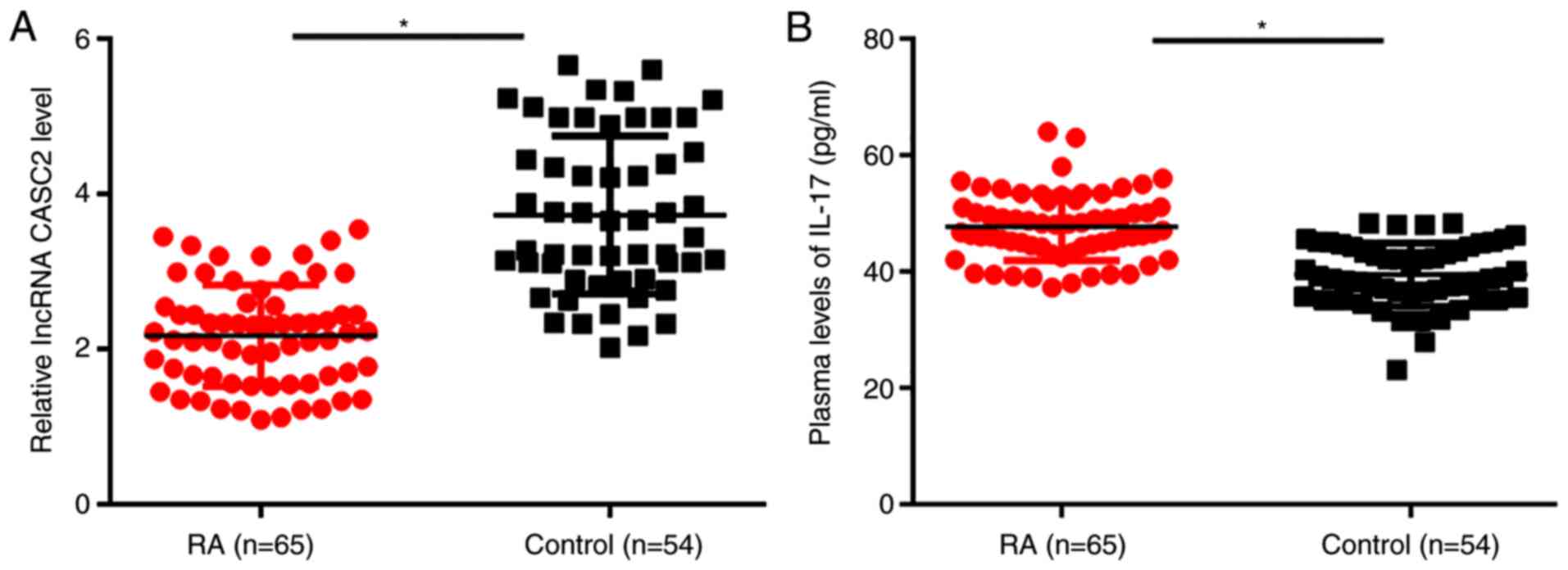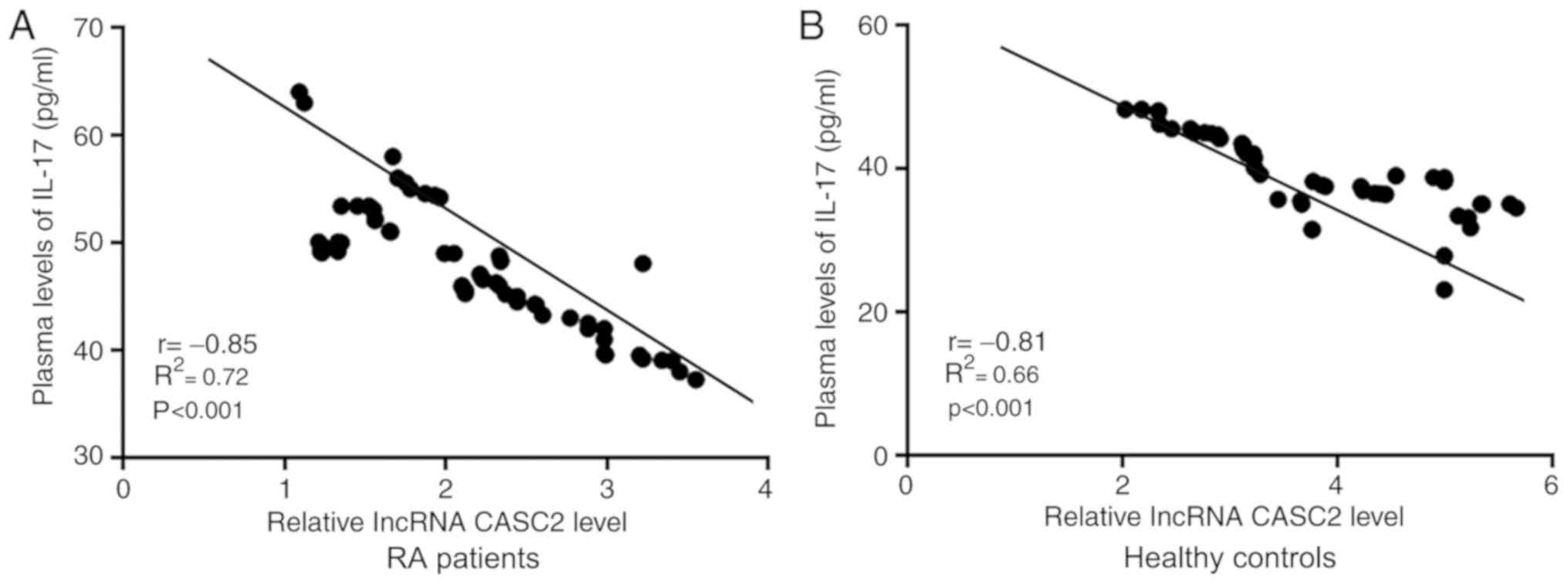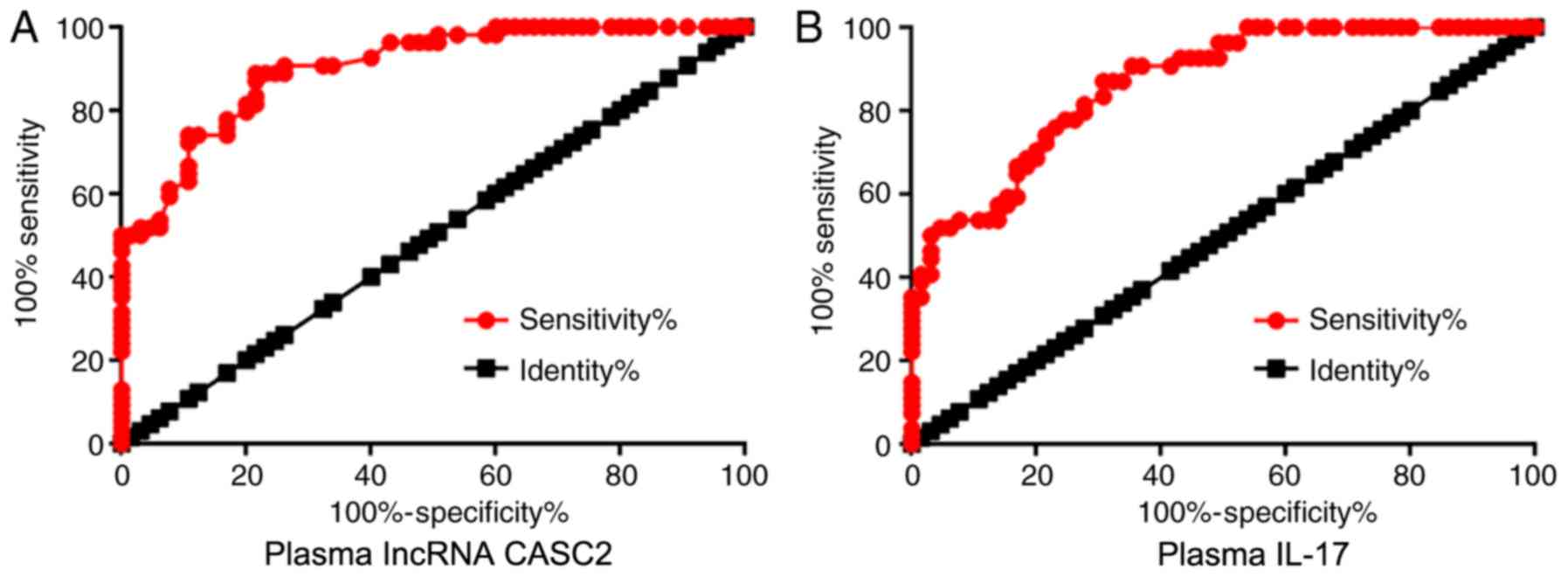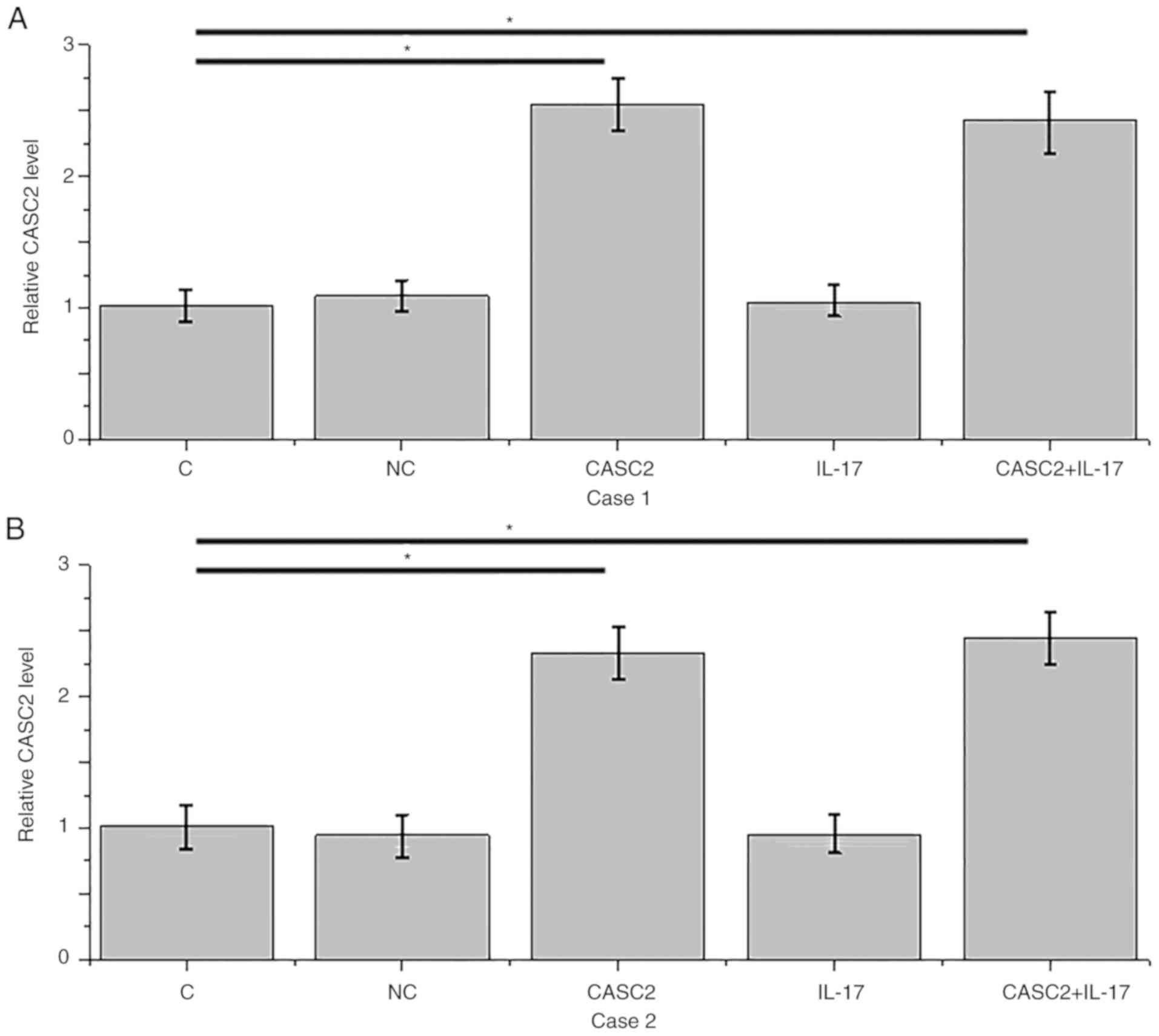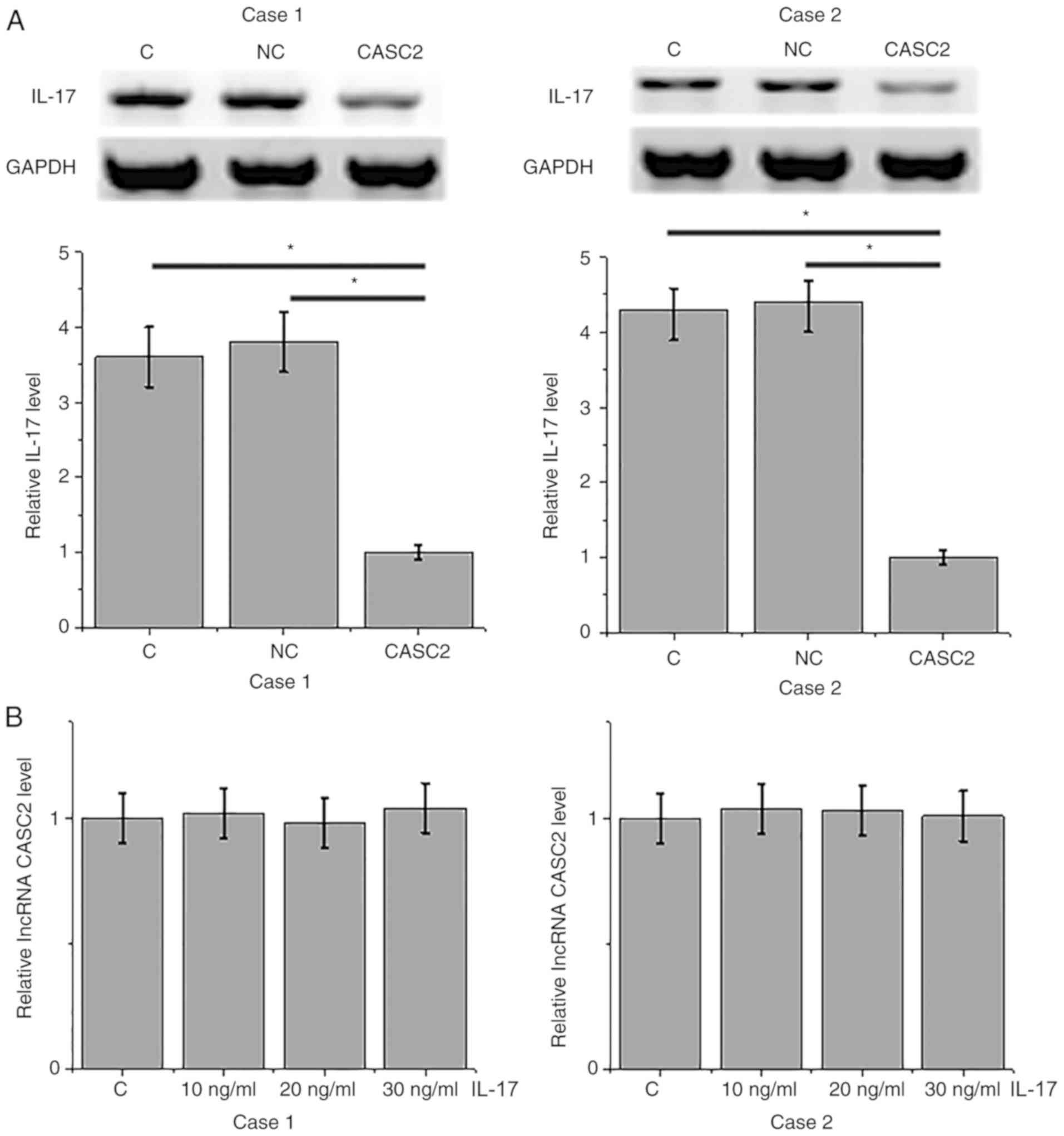Introduction
As a type of autoimmune disorder that mainly affects
the joints, progression of rheumatoid arthritis (RA) causes
progressive articular destruction and comorbidities in metabolic,
vascular, psychological domains and bone (1). RA affects about 1% of the population
at any stage of age, and the incidence is higher in males than in
females (2). Due to the efforts
made in regards to the treatment and prevention of RA, treatment
outcomes of RNA have been significantly improved during the past
several decades (3,4). However, sustained remission is still
rare and ongoing pharmacologic therapy is always required (5). Moreover, the cause of RA remains
unclear. In addition, sensitive diagnostic and prognostic
biomarkers for RA are lacking.
As a type of inflammatory disease, the development
of RA requires the involvement of multiple inflammatory cytokine
(6). Thus, anti-inflammation is
currently considered as a promising therapeutic target for RA
treatment (7). As a
pro-inflammatory factor, IL-17 is upregulated in RA and the
overexpression of IL-17 contributes to the progression of RA
through multiple aspects, such as angiogenesis (8). A growing body of literature has also
shown that the development of RA also requires the participation of
lncRNAs (9,10). lncRNA CASC2 has been characterized
as an oncogenic lncRNA in different types of cancers (11,12).
Previous studies have shown that lncRNA CASC2 can participate in
cancer biology by affecting cell behaviors, such as cell
proliferation, migration and invasion (11,12).
However, the role of this lncRNA in other types of human diseases
is unknown. Our preliminary microarray data revealed that lncRNA
CASC2 is downregulated in the plasma of RA patients and showed an
inverse correlation with the expression of IL-17. In the present
study, it was demonstrated that downregulation of lncRNA CASC2
participates in RA and overexpression of lncRNA CASC2 may promote
the apoptosis of human fibroblast-like synoviocytes by
downregulating IL-17.
Materials and methods
Plasma specimens and human
fibroblast-like synoviocytes
Plasma samples were obtained from 65 RA patients
(patient group) and 54 healthy controls (control group) who were
admitted to the First People's Hospital of Tianmen City from
January 2015 to July 2018. Inclusion criteria of patients included:
i) Patients diagnosed with RA for the first time; ii) patients with
a complete medical record; iii) patients understood the
experimental protocol and signed an informed consent. Exclusion
criteria included: i) Patients diagnosed with multiple diseases;
ii) patients received treatment before admission. The 54 healthy
controls were selected from the Physiological Examination Center of
the First People's Hospital of Tianmen City to match the age and
sex distributions of the patient group. The patient group included
36 males and 29 females, and the ages ranged from 29 to 66 years,
with a mean age of 47.1±5.2 years. The control group included 29
males and 25 females, and ages ranged from 27 to 68 years, with a
mean age of 47.8±6.1 years. No significant differences in age and
sex were found between the two groups. The present study was
approved following the review of the Ethics Committee of the First
People's Hospital of Tianmen City. All participants signed informed
consent before participating.
Human fibroblast-like synoviocytes (HFLSs) were
isolated from 2 RA patients according to the methods described by
Lee et al (13). HELSs were
collected from passage 3 to 5 for subsequent experiments.
Total RNA extraction and reverse
transcription-quantitative PCR (RT-qPCR)
To detect the expression of lncRNA CASC2, total RNA
extraction was performed using a Monarch® Total RNA
Miniprep kit (New England BioLabs, Inc., Ipswich, MA, USA). cDNA
was synthesized using a High-Capacity cDNA Reverse Transcription
kit (Thermo Fisher Scientific, Inc., Waltham, MA, USA) at 25°C for
5 min, 50°C for 30 min and 75°C for 5 min. A Luna®
Universal One-Step RT-qPCR kit (New England BioLabs, Inc.) was used
to prepare all PCR reaction systems. Primers for the lncRNA CASC2
and endogenous control GAPDH were designed and synthesized by
Sangon Biotech Co., Ltd. (Shanghai, China). The primer sequences
were: CASC2, forward, 5′-TACAGGACAGTCAGTGGTGGTA-3′ and reverse,
5′-ACATCTAGCTTAGGAATGTGGC-3′; and GAPDH, forward,
5′-TCAAGAAGGTGGTGAAGCA-3′ and reverse, 5′-AGGTGGAGGAGTGGGTGT-3′.
The qPCR reaction conditions consisted of 95°C for 1 min, followed
by 40 cycles of 95°C for 10 sec and 56.5°C for 30 sec. Expression
of lncRNA CASC2 was normalized to GAPDH using the 2−ΔΔCq
method (14).
Enzyme-linked immunosorbent assay
To measure the plasma levels of IL-17, enzyme-linked
immunosorbent assay (ELISA) was performed using Human IL-17
Quantikine ELISA Kit (cat. no. D1700; R&D Systems, Inc.,
Minneapolis, MN, USA). All operations were performed according to
the instructions provided by R&D Systems, Inc. Plasma levels of
IL-17 were normalized to pg/ml.
Cell transfection
lncRNA CASC2-expression (pcDNA3) vectors were
designed and synthesized by Sangon Biotech Co., Ltd. (Shanghai,
China). The genomic DNA sequence of lncRNA CASC2 was used. Cell
transfections were performed using Lipofectamine® 2000
reagent (Invitrogen; Thermo Fisher Scientific, Inc.), with all
steps performed according to the manufacturer's instructions.
Lipofectamine 2000 reagent was first mixed with vectors to form a
reagent-vector complex, followed by incubation with cells
(105 cells/ml) at 37°C for 5 h for each transfection.
The dose of the vectors was 10 nM. The negative control consisted
of empty vector transfection. Control cells were cells treated only
with Lipofectamine 2000 reagent.
Cell apoptosis assay
The overexpression rate of lncRNA CASC2 reached 200%
at 24 h after transfection. Therefore, cell apoptosis was detected
by cell apoptosis assay at this time point. Serum-free cell culture
medium was used to prepare single-cell suspensions with a cell
density of 5×104 cells/ml. The cell suspension was
transferred to a 6-well plate with 2 ml in each well. Cells were
cultivated at 37°C for 48 h and were then digested with 0.25%
trypsin. After that, Annexin V-FITC (Dojindo Molecular
Technologies, Inc., Kumamoto, Japan) and propidium iodide staining
was performed at 4°C for 30 min, and apoptotic cells were detected
by flow cytometry. Data were analyzed using FCS Express 6 Flow
Cytometry Software (De Novo Software, Glendale, CA, USA).
Western blot analysis
To detect the expression of IL-17, total protein
extraction was performed using a total protein extraction kit (cat.
no. 2140; Merck KGaA, Darmstadt, Germany). Protein samples were
quantified using a Pierce™ BCA Protein Assay kit (Pierce; Thermo
Fisher Scientific, Inc.). After denaturing, protein samples (30
µg/lane) were subjected to 10% SDS-PAGE, followed by gel transfer
to PVDF membranes. After blocking in 5% non-fat milk at 25°C for 2
h, the membranes were subjected to incubation with primary
antibodies [rabbit anti-human IL-17 (1:1,200; cat. no. ab79056;
Abcam, Cambridge, UK) and rabbit anti-human GAPDH (1:1,400; cat.
no. ab9485; Abcam; 1:1,400) overnight at 4°C, followed by
incubation with horseradish peroxidase--conjugated goat anti-rabbit
IgG secondary antibody (1:1,000; cat. no. MBS435036; MyBioSource,
Inc., San Diego, CA, USA) for 2 h at 22°C. ECL (Sigma-Aldrich;
Merck KGaA) was used to develop signals and signals were normalized
using ImageJ v.1.48 software (National Institutes of Health,
Bethesda, MD, USA).
Statistical analysis
All experiments were carried out in triplicate, and
data are expressed as the mean ± standard deviation. All
statistical analyses were performed using GraphPad Prism 6 software
(GraphPad Software, Inc., La Jolla, CA, USA). Correlations between
plasma levels of lncRNA CASC2 and IL-17 were analyzed by Pearson's
correlation coefficient. Receiver operating characteristic (ROC)
analysis was performed to evaluate the diagnostic values of plasma
lncRNA CASC2 and IL-17 for RA with RA patients as true positive
cases and healthy controls as true negative cases. Comparisons
between 2 groups were performed by unpaired t test. Comparisons
among 3 groups were performed by one-way ANOVA followed by Tukey
post hoc test. Differences were deemed statistically significant at
P<0.05.
Results
lncRNA CASC2 is downregulated, while
IL-17 is upregulated in the plasma of RA patients
Results of qPCR showed that, compared with the
healthy controls, plasma levels of lncRNA CASC2 were significantly
decreased in patients with RA (P<0.05; Fig. 1A). In contrast, ELISA results
showed that plasma IL-17 was upregulated in the plasma of RA
patients when compared with that in the plasma of healthy controls
(P<0.05; Fig. 1B).
Plasma levels of lncRNA CASC2 and
IL-17 are significantly and inversely correlated in both RA
patients and healthy controls
Correlations between plasma levels of lncRNA CASC2
and IL-17 were analyzed by Pearson's correlation coefficient. As
shown in Fig. 2, plasma levels of
lncRNA CASC2 and IL-17 were significantly and inversely correlated
in both RA patients (Fig. 2A) and
healthy controls (Fig. 2B).
Altered plasma levels of lncRNA CASC2
and IL-17 differentiate RA patients from healthy controls
ROC curve analysis was performed to evaluate the
diagnostic values of plasma lncRNA CASC2 and IL-17 for RA with RA
patients as true positive cases and healthy controls as true
negative cases. For plasma lncRNA CASC2, area under the curve was
0.90, with standard error of 0.026 and 95% confidence interval of
0.85–0.95 (Fig. 3A). For plasma
IL-17, area under the curve was 0.86, with standard error of 0.032
and 95% confidence interval of 0.80–0.93 (Fig. 3B).
lncRNA CASC2 overexpression promotes
while IL-17 inhibits the apoptosis of HFLSs
Compared with the control (C) and negative control
(NC) groups, overexpression of lncRNA CASC2 was reached after
transfection of HFLSs isolated from 2 RA patients (P<0.05;
Fig. 4A and B). Overexpression of
lncRNA CASC2 led to significant promotion of apoptosis of HFLSs
isolated from 2 RA patients (Fig. 4C
and D, P<0.05). In contrast, treatment with IL-17 at a dose
of 10 ng/ml significantly inhibited the apoptosis of HFLSs
(P<0.05; Fig. 4C and D). In
addition, IL-17 treatment attenuated the promoting effect of lncRNA
CASC2 overexpression on cell apoptosis (P<0.05).
lncRNA CASC2 is a potential upstream
inhibitor of IL-17 in HFLSs
Compared with the control (C) and negative control
(NC) groups, overexpression of lncRNA CASC2 led to a significant
inhibition of expression of IL-17 in HFLSs isolated from 2 RA
patients (P<0.05; Fig. 5A). In
contrast, treatment with IL-17 at doses of 10, 20 and 30 ng/ml did
not significantly affect the expression of lncRNA CASC2.
Discussion
lncRNA CASC2 has been characterized as an oncogenic
lncRNA in different types of cancers, while the role of this lncRNA
in other types of human diseases is unknown. The key finding of the
preset study is that lncRNA CASC2 is downregulated in RA and the
overexpression of lncRNA CASC2 inhibited IL-17 expression and
promoted apoptosis of HFLSs isolated from RA patients.
A recent study showed that RA affected the
expression pattern of a large set of lncRNAs (15). In another study, lncRNA HOTIAR was
confirmed to be an essential regulator and clinical marker for RA
(9). In addition, Yang and Chen
showed that lncRNA-NR024118 interacts with shikonin to inhibit the
inflammatory response in RA (10).
In the present study, downregulation of lncRNA CASC2 was observed
in the plasma of RA patients when compared with that noted in
healthy controls. In addition, downregulation of lncRNA CASC2 was
able to effectively differentiate RA patients from healthy
controls. Therefore, lncRNA CASC2 may serve as a potential
diagnostic marker for RA.
Overexpression of IL-17 is frequently observed in RA
and upregulated IL-17 promotes RA development (8). Consistently, in the present study,
the upregulation of IL-17 was observed in RA patients when compared
to that noted in healthy controls. It is known that IL-17 may
interact with lncRNAs to participate in biological processes
(16,17). At present, the molecular mechanisms
of the actions of lncRNAs in RA remain largely unknown.
Importantly, a significant and inverse correlation was found
between lncRNA CASC2 and IL-17 in both RA patients and healthy
controls. In addition, our in vitro cell experiments also
showed that overexpression of lncRNA CASC2 led to significant
inhibition of the expression of IL-17 in HFLSs isolated from RA
patients. These data suggest the involvement of lncRNA CASC2 in RA
by inhibiting IL-17.
HFLSs participate in the development and progression
of RA by producing cytokines and proteases that contribute to
cartilage destruction (18).
Apoptosis of HFLSs is currently considered as a potential
therapeutic target for RA (19,20).
Our study observed that IL-17 inhibited HFLSs apoptosis, while
lncRNA CASC2 promoted HFLSs apoptosis by inhibiting IL-17.
Therefore, overexpression of lncRNA CASC2 may be used to treat RA.
However, the molecular mechanism of the involvement of IL-17 and
CASC2 in the apoptosis of HFLSs is still unknown. Further research
is warranted.
In conclusion, lncRNA CASC2 is downregulated, while
IL-17 is upregulated in RA. lncRNA CASC2 overexpression promotes
the apoptosis of HFLSs by downregulating IL-17, thereby suppressing
the progression of RA.
Acknowledgements
Not applicable.
Funding
No funding was received.
Availability of data and materials
The datasets used and/or analyzed during present
study are available from the corresponding author on reasonable
request.
Authors' contributions
CL performed all the experiments, analyzed all the
data and was a major contributor in writing the manuscript. XG, SB,
GZ and HW also contributed to performing the experimental tasks and
aided in the drafting of the manuscript. All authors read and
approved the final manuscript and agree to be accountable for all
aspects of the research in ensuring that the accuracy or integrity
of any part of the work are appropriately investigated and
resolved.
Ethics approval and consent to
participate
Ethical approval was obtained from the First
People's Hospital of Tianmen City Medical Research Ethics
Committee. The study followed the tenets of the Declaration of
Helsinki, and informed written consent was obtained from all
patients and controls.
Patient consent for publication
Not applicable.
Competing interests
The authors declare that they have no competing
interests.
References
|
1
|
McInnes IB and Schett G: The pathogenesis
of rheumatoid arthritis. N Engl J Med. 365:2205–2219. 2011.
View Article : Google Scholar : PubMed/NCBI
|
|
2
|
McInnes IB and Schett G: Pathogenetic
insights from the treatment of rheumatoid arthritis. Lancet.
389:2328–2337. 2017. View Article : Google Scholar : PubMed/NCBI
|
|
3
|
Monti S, Montecucco C, Bugatti S and
Caporali R: Rheumatoid arthritis treatment: The earlier the better
to prevent joint damage. RMD Open. 1 (Suppl 1):e0000572015.
View Article : Google Scholar : PubMed/NCBI
|
|
4
|
Stevenson M, Archer R, Tosh J, Simpson E,
Everson-Hock E, Stevens J, Hernandez-Alava M, Paisley S, Dickinson
K, Scott D, et al: Adalimumab, etanercept, infliximab, certolizumab
pegol, golimumab, tocilizumab and abatacept for the treatment of
rheumatoid arthritis not previously treated with disease--modifying
antirheumatic drugs and after the failure of conventional
disease-modifying antirheumatic drugs only: Systematic review and
economic evaluation. Health Technol Assess. 20:1–610. 2016.
View Article : Google Scholar
|
|
5
|
Smolen JS, Breedveld FC, Burmester GR,
Bykerk V, Dougados M, Emery P, Kvien TK, Navarro-Compán MV, Oliver
S, Schoels M, et al: Treating rheumatoid arthritis to target: 2014
update of the recommendations of an international task force. Ann
Rheum Dis. 75:3–15. 2016. View Article : Google Scholar : PubMed/NCBI
|
|
6
|
Choy EH and Panayi GS: Cytokine pathways
and joint inflammation in rheumatoid arthritis. N Engl J Med.
344:907–916. 2001. View Article : Google Scholar : PubMed/NCBI
|
|
7
|
Silverstein FE, Faich G, Goldstein JL,
Simon LS, Pincus T, Whelton A, Makuch R, Eisen G, Agrawal NM,
Stenson WF, et al: Gastrointestinal toxicity with celecoxib vs
nonsteroidal anti-inflammatory drugs for osteoarthritis and
rheumatoid arthritis: The CLASS study: A randomized controlled
trial. celecoxib long-term arthritis safety study. JAMA.
284:1247–1255. 2000. View Article : Google Scholar : PubMed/NCBI
|
|
8
|
Pickens SR, Volin MV, Mandelin AM II,
Kolls JK, Pope RM and Shahrara S: IL-17 contributes to angiogenesis
in rheumatoid arthritis. J Immunol. 184:3233–3241. 2010. View Article : Google Scholar : PubMed/NCBI
|
|
9
|
Song J, Kim D, Han J, Kim Y, Lee M and Jin
EJ: PBMC and exosome-derived Hotair is a critical regulator and
potent marker for rheumatoid arthritis. Clin Exp Med. 15:121–126.
2015. View Article : Google Scholar : PubMed/NCBI
|
|
10
|
Yang KY and Chen DL: Shikonin inhibits
inflammatory response in rheumatoid arthritis synovial fibroblasts
via lncRNA-NR024118. Evid Based Complement Alternat Med.
2015:6317372015. View Article : Google Scholar : PubMed/NCBI
|
|
11
|
Pei Z, Du X, Song Y, Fan L, Li F, Gao Y,
Wu R, Chen Y, Li W, Zhou H, et al: Down-regulation of lncRNA CASC2
promotes cell proliferation and metastasis of bladder cancer by
activation of the Wnt/β-catenin signaling pathway. Oncotarget.
8:18145–18153. 2017. View Article : Google Scholar : PubMed/NCBI
|
|
12
|
Cao Y, Xu R, Xu X, Zhou Y, Cui L and He X:
Downregulation of lncRNA CASC2 by microRNA-21 increases the
proliferation and migration of renal cell carcinoma cells. Mol Med
Rep. 14:1019–1025. 2016. View Article : Google Scholar : PubMed/NCBI
|
|
13
|
Lee SY, Kwok SK, Son HJ, Ryu JG, Kim EK,
Oh HJ, Cho ML, Ju JH, Park SH and Kim HY: IL-17-mediated Bcl-2
expression regulates survival of fibroblast-like synoviocytes in
rheumatoid arthritis through STAT3 activation. Arthritis Res Ther.
15:R312013. View
Article : Google Scholar : PubMed/NCBI
|
|
14
|
Livak KJ and Schmittgen TD: Analysis of
relative gene expression data using real-time quantitative PCR and
the 2(-Delta Delta C(T)) method. Methods. 25:402–408. 2001.
View Article : Google Scholar : PubMed/NCBI
|
|
15
|
Zhang Y, Xu YZ, Sun N, Liu JH, Chen FF,
Guan XL, Li A, Wang F, Zhao QF, Wang HY, et al: Long noncoding RNA
expression profile in fibroblast-like synoviocytes from patients
with rheumatoid arthritis. Arthritis Res Ther. 18:2272016.
View Article : Google Scholar : PubMed/NCBI
|
|
16
|
Huang XD, Dai JG, Lin KT, Liu M, Ruan HT,
Zhang H, Liu WG, He MX and Zhao M: Regulation of IL-17 by lncRNA of
IRF-2 in the pearl oyster. Fish Shellfish Immunol. 81:108–112.
2018. View Article : Google Scholar : PubMed/NCBI
|
|
17
|
Huang W, Thomas B, Flynn RA, Gavzy SJ, Wu
L, Kim SV, Hall JA, Miraldi ER, Ng CP, Rigo F, et al: DDX5 and its
associated lncRNA Rmrp modulate TH17 cell effector functions.
Nature. 528:517–522. 2015. View Article : Google Scholar : PubMed/NCBI
|
|
18
|
Bartok B and Firestein GS: Fibroblast-like
synoviocytes: Key effector cells in rheumatoid arthritis. Immunol
Rev. 233:233–255. 2010. View Article : Google Scholar : PubMed/NCBI
|
|
19
|
Zou S, Wang C, Cui Z, Guo P, Meng Q, Shi
X, Gao Y, Yang G and Han Z: β-Elemene induces apoptosis of human
rheumatoid arthritis fibroblast-like synoviocytes via reactive
oxygen species-dependent activation of p38 mitogen-activated
protein kinase. Pharmacol Rep. 68:7–11. 2016. View Article : Google Scholar : PubMed/NCBI
|
|
20
|
Li S, Jin Z and Lu X: MicroRNA-192
suppresses cell proliferation and induces apoptosis in human
rheumatoid arthritis fibroblast-like synoviocytes by downregulating
caveolin 1. Mol Cell Biochem. 432:123–130. 2017. View Article : Google Scholar : PubMed/NCBI
|















